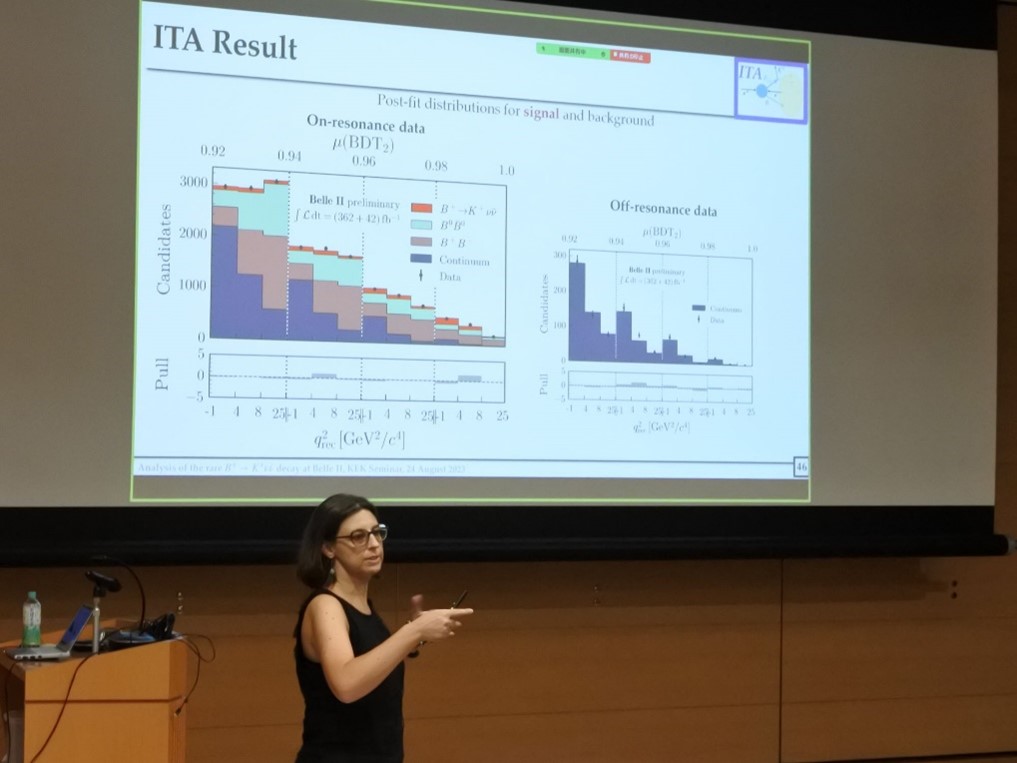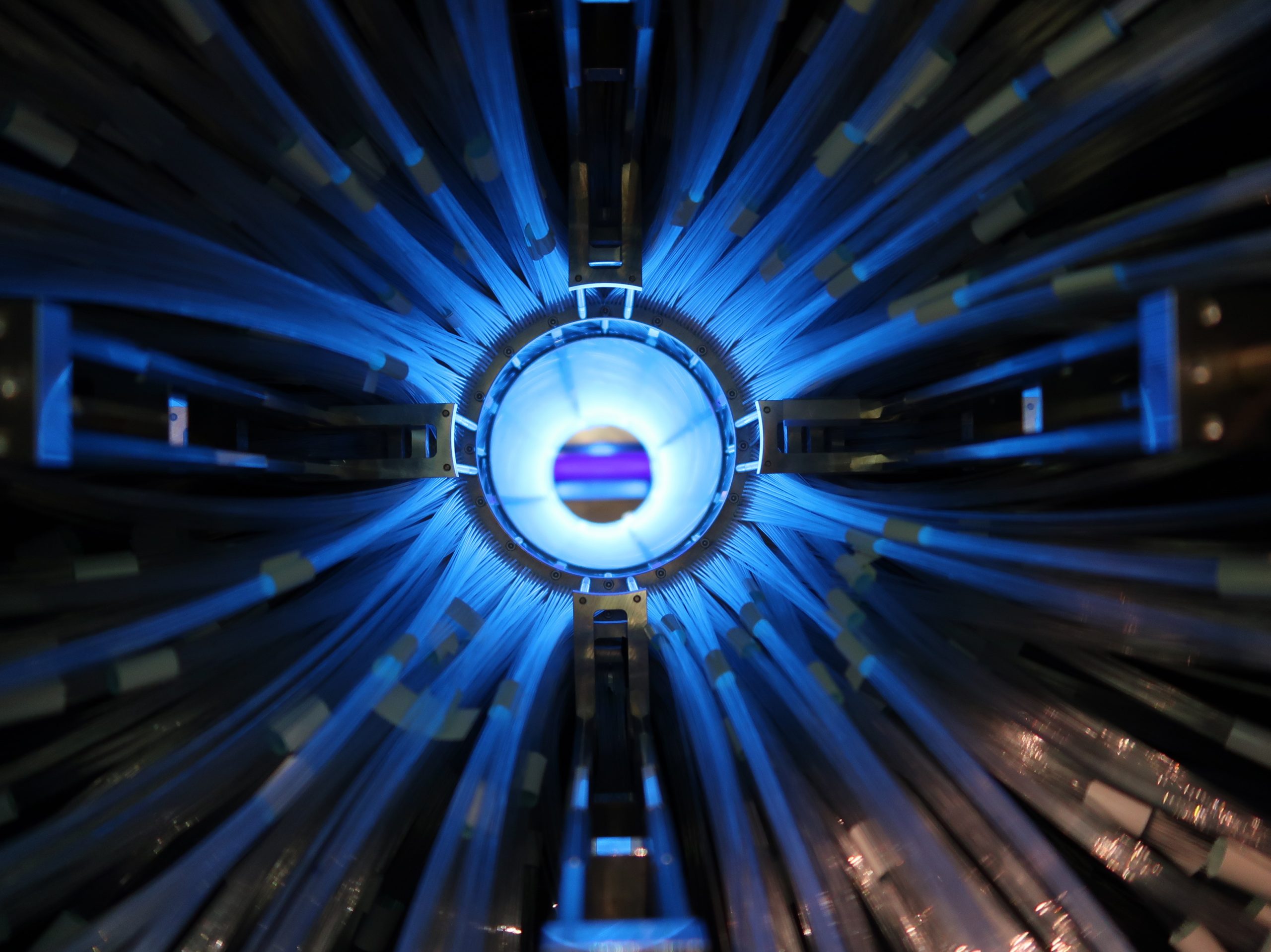- Topics
Belle II Experiment: The first evidence for a very rare decay of the B meson
September 20th, 2023
-

Dr. Roberta Volpe (University of Perugia)
On 24 August, 2023, the Belle II Collaboration presented results detailing the first measurement of a very rare phenomenon, the decay of the B mesons into a K meson and two neutrinos. The study of this decay of the B meson is one of the crucial elements of the search for new physics, the aim of the Belle II Experiment.
The Belle II Experiment is currently undergoing its first long shutdown (LS1) , which started in the summer of 2022. During this break, significant improvements have been made to the accelerator and detector; it is planned to resume operations by the end of this year. Throughout the shutdown, many analyses have been conducted using all the data collected by Belle II from 2019 to 2022. This announcement reported the result of one of the many exciting analyses that have used the entire current Belle II dataset.
In reporting the results, presentations were made at the same time at an international conference, EPS-HEP held in Hamburg, Germany; and at a seminar organized by the Institute of Particle and Nuclear Studies (IPNS) at KEK. The latter took place at Kobayashi Hall, on KEK’s Tsukuba Campus, and attracted over 100 researchers, attending in-person or online. Following the seminar, an interview was conducted with the speaker of the presentation, Dr. Roberta Volpe from the University of Perugia, and Dr. Mikihiko Nakao, the leader of the IPNS Belle Group.
What makes this process of a B meson decaying into a K meson and two neutrinos such a very rare phenomenon? And what is the scientific impact from studying this process?
This decay process is considered “very rare”, i.e. it has a very small probability, for two reasons:
Firstly, at the quark level of the decay process, the bottom quark within the B meson decays into a “strange” quark, a process which involves a “loop” diagram. In this loop diagram, when the bottom quark changes to a strange quark, it has to virtually produce a heavy top quark as an intermediate state, and hence the quark species have to change twice. Because the process can only take place via this diagram, involving multiple transitions to/from a heavy quark, the probability is very small.
Secondly, neutrinos are emitted through heavy “weak bosons” (Z bosons or W bosons), and these heavy particles also have to be virtually produced. Due to the small probability for this to occur, the overall probability of this process is even smaller.
In general, it is easier to produce theoretical predictions for decay processes involving leptons (such as electrons or muons) and among these, those processes involving neutral leptons (neutrinos) allow us to perform even more reliable theoretical calculations.
Therefore, even though the process involving B mesons decaying into a K meson and two neutrinos is very rare, it offers an accessible method to compare experimental results with the Standard Model of Particle Physics. Investigating these rare processes is crucial to verify the Standard Model and to explore theories beyond it. If there were any involvement of new particles of yet-unknown new physics in any intermediate states, it would manifest as a deviation of the measurement from the Standard Model predictions, and hence it is crucial to make the uncertainties as small as possible in both the measurements and the theoretical predictions. The very small probability could also make the, presumably tiny, difference due to the new physics effect relatively more visible. Methods such as this one, that search for new physics through phenomena in which the quark or lepton flavors change, are referred to as flavor physics.
What challenges did you face while analyzing the data?
The most challenging aspect of our analysis was from the background events that we did not expect. When we know in advance that specific types of background events will be abundant, we can account for this when we develop the analysis. However, sometimes there are background contributions, which were initially considered negligible from the results of our simulations, but are later found to be not well-modelled and they can have a major impact on the analysis. This kind of mis-modelling can lead to incorrect results and hence is particularly dangerous. It is not necessarily an error with the analysis method, but it just means that we encountered a new challenge that was not previously known within the particle physics community. To address the contributions of these types of background events, we evaluated them particularly carefully using additional data known as control samples – these control samples are selected in such a way so as to not overlap with the events of interest and allow us to study the challenging background events. In other cases, we use experimental results from other experiments. In addition, we assign a large systematic uncertainty to these estimations considering that we do not understand them very well.
Were there any other challenges while working on this analysis?
The primary challenge of this data analysis was due to the fact that this particular decay process we have a B meson decaying into three particles: a K meson and two neutrinos.
Neutrinos are particles that cannot be directly detected by our experiment. As a result, we have limited information about the undetected neutrinos. If there were only one neutrino in the event, we could reconstruct the behavior of the neutrino from all other particles in the final state, but this is not possible with two or more neutrinos. So we have make use of all the available indirect evidence to characterize this decay.
How long did it take to obtain the results?
In the field of accelerator-based particle physics experiments, the development of a data analysis method can often take several years, especially if it is a complex and crucial analysis like this one. Preparations often begins well ahead of the actual experimental data taking, but still, the most critical component is the data. The data used in this analysis was collected from 2019 to 2022. During this period, various improvements and optimizations to the analysis methods were made. Additionally, control samples from some of the collected data were used to validate the analysis techniques. In 2021, using an earlier version of this data analysis method, we made a search of this decay process with a smaller amount of data. At that time, we could not find the signal of this decay process, but we reported a result on a meaningful upper limit. Therefore, the general strategy for this data analysis was already well-established by the time we began analyzing the entire data.
Is this result in agreement with the prediction of the Standard Model of Particle Physics? If not, does it imply there is new physics beyond the Standard Model?
The central value of our branching fraction measurement (i.e. the probability for this decay to occur) is approximately five times higher than the prediction of the Standard Model. However, it is still possible that this difference is due to a statistical fluctuation. According to the standard approach used in particle physics experiments, when the difference between the measurement and prediction exceeds three times the standard deviation of the result, it is considered “evidence” for new physics. In our results, the difference is 2.8 times the standard deviation.
On the other hand, if we consider the case of this decay process not occurring at all in nature, the difference with respect to our result exceeds three times the standard deviation, thus providing “evidence” that this decay process does occur. Therefore, while it is not evidence for new physics, it is a result that attracts the attention of the particle physics community. It is an opportunity to focus on all the data analyses and theoretical studies related to this measurement, and explore the potential implications of this result.
What do you think will be the scientific impact of the this result?
The flavor physics community has been waiting for this measurement for a long time. This is the first evidence that this process exists and this is already an important achievement. The fact that we see some deviation from the Standard Model makes this result even more interesting and exciting. On the other hand, in the past there have been many tantalising indications of new physics, some of which were mere statistical fluctuations and disappeared later after collecting more data, so we should be cautious about this new result too.
What are the next steps for this analysis?
Firstly, we will look forward to collecting more data. This will certainly help reduce measurement uncertainties. Secondly, even with the current data, there are additional techniques that can be applied to measure this same decay process that have not been attempted yet. It would be very interesting to see if results from alternative methods align with the findings of this study, and show consistency with the Standard Model or deviations from it. Thirdly, measurements of other decay processes which are related to this measurement will be conducted. While these processes may differ from what was studied here, they share the same underlying physics at level of the quarks involved. This would provide us with further useful information for understanding the implications of our current result.








